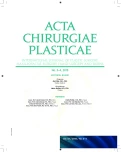A-05 LID IMPLANTS IN THE THERAPY OF LAGOPHTHALMUS
Authors:
M. Odehnal 1; M. Chovanec 2; J. Malec 1; G. Mahelková 1; K. Ferrová 1; D. Dotřelová 1
Authors‘ workplace:
University Hospital Motol, Ophthalmology Department for Children and Adults, nd Medical Faculty Charles University and Motol University Hospital, Prague, Czech Republic
1; University Hospital Motol, Department of Otorhinolaryngology and Head and Neck Surgery, 1st Medical Faculty, Charles University and Motol University Hospital, Prague, Czech Republic
2
Published in:
ACTA CHIRURGIAE PLASTICAE, 57, 3-4, 2015, pp. 51-53
Category:
Selected abstracts from the 36th national congress of the czech society plastic surgery with international participation
Introduction
Lagophthalmus is a pathological condition based on inability to close the eye lids. The most frequent cause of lagophthalmus is palsy of the facial nerve. This complex clinical entity is characterized by palsy of the orbicularis oculi muscle. The result is permanent exposure of the surface of the cornea with a resulting clinical picture of a dry eye. Recurrent keratitis and ulcers in the cornea could result in perforation of the eye with all consequences for ocular function. The clinical picture includes also reduced production of tears, retraction of the upper lid and ectropium of the lower lid. The main goal of an ophthalmologist is to maintain integrity of the cornea. The first step is permanent application of artificial tears in a form of drops and gels or usage of moist chamber. During progression of keratopathy, it is necessary to perform tarsorrhaphy. Reanimation of the facial nerve, its anastomosis, transfers of facial muscles or use of silicone cannulas to strengthen the lids are other treatment options. Modern and effective method for the treatment of lagophthalmus is usage of lid implants, the function of which is based on weight and gravitation force. Implant fixed to tarsal plate of the upper lid enables closure of the eye slit and protection of corneal epithelium. Long term functional and cosmetic results are very good and there is a minimum of complications.
Methods
During the period from May 2004 to September 2014, we used eyelid implants to 72 patients (42 men, 30 women) at the Ophthalmology Department for Children and Adults, 2nd Medical Faculty, Charles University and Motol University Hospital. The indication of the operation was lagophthalmus with signs of exposure keratitis that developed as a result of facial nerve palsy. The most frequent cause of lagophthalmus was a tumor, followed by cerebrovascular accidents. The age of patients ranged from 4 years to 82 years. The average period of observation in the group was 6.5 years (5 months to 10 years). The time interval of implant application since the development of facial nerve palsy ranged from 3 months to 10 years (median 1 year). The extent of corneal damage was evaluated using a scale of degrees from superficial damage to significant changes in the cornea. For evaluation of the function of the lid contractor we used the criteria of House-Brackmann scale. Before the operation we used a set of trial implants to find the optimal weight of the definite implant, which was produced from 24 carat gold. Most frequently we used the implants with a weight of 1.6 g (1.2–1.9 g).
Description of the surgery: Skin incision is performed under the upper edge of the tarsal plate, approx. in a length corresponding to the implant. With the dissection of the muscle of the lid contractor downwards and slightly laterally, approx. 3-4 mm to the margin of the lid, is created a skin-muscle “pocket” for the actual implant. Implant is fixed with 3 fixation holes on the anterior surface of the tarsal plate using non-absorbable stitches. The whole surgical area is flushed with antibiotic solution and the lid is sutured by single layers.
Results
The average level of lagophthalmus before operation was 5.5 mm in our patients, after the operation was the reduction of lagophthalmus in average to 1.5 mm. In 85% of patients we reported improvement of biomicroscopic condition of the cornea within one year from implantation. Visual acuity after implantation significantly improved in 35% of patients. In the satisfaction questionnaire was reported improvement of quality of life in 89% of patients. In the postoperative complications in one patient occurred inflammatory extrusion of the implant within the interval of two years after the operation, in another patient occurred allergy to gold and the implant was extruded within 1 year postoperatively. In both patients we reimplanted the implant after 6 months (in a patient with allergy to gold we used an implant made of platinum).
Conclusion
At the Ophthalmology Department, we used as the first in the Czech Republic the method of lagophthalmus therapy in adults and pediatric patients using lid implants and demonstrated efficiency. Lid implants provide cosmetic and functional benefits with permanent protection of the eye and significantly improve quality of life of the patients. (Fig. 5.1, 5.2, 5.3, 5.4.)



Sources
1. Bladen JC, Norris JH, Malhotra R. Indications and outcomes for revision of gold weight implants in upper eyelid loading. Br J Ophthalmol. 2012 Apr;96(4):485–9.
2. Chapman P, Lamberty BG. Results of upper lid loading in the treatment of lagophthalmos caused by facial palsy. Br J Plast Surg. 1988 Jul;41(4):369–72.
3. Odehnal M, Malec J, Dotřelová D. Víčkové implantáty v terapii lagoftalmu.
Cesk Slov Neurol Neurochir. 2011,74(4),459–62.
Labels
Plastic surgery Orthopaedics Burns medicine TraumatologyArticle was published in
Acta chirurgiae plasticae

2015 Issue 3-4
Most read in this issue
- 36th NATIONAL CONGRESS OF THE CZECH SOCIETY OF PLASTIC SURGERY WITH INTERNATIONAL PARTICIPATION
- Dorsoradial forearm flap with silicone bone spacer in reconstruction of A combined THUMB injury – case report
-
ZORA JANŽEKOVIČ
(September 30, 1918 – March 17, 2015) - Editorial

